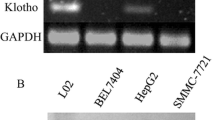Summary
In this study, the mechanism by which Ad-p27mt inhibits the growth, invasion and metastasis of transplanted liver tumor was studied by examining the effects of Ad-27mt gene transfer on the expression of Bax, Bcl-2, VEGF and MMP-9 in the transplanted liver tumors in nude mice. The model of transplanted hepatic tumor was established in nude mice. The mice were then divided into three groups, which were injected with PBS, Ad-LacZ and Ad-p27mt and the growth of the transplanted liver tumor was observed. The expressions of P27, Bax and Bcl-2 proteins were detected by Western blotting and the expressions of VEGF and MMP-9 were immunohistochemically determined. Our result showed that the tumor size, expressions of Bax, Bcl-2 proteins, VEGF and MMP-9 were all lower than those in PBS and Ad-LacZ groups and the differences were statistically significant (P<0.05). Our study suggested that Ad-p27mt could inhibit the growth, invasion and metastasis of hepatic cancer by lowering the expressions of VEGF and MMP-9.
Similar content being viewed by others
References
Turrell SJ, Whitehouse A. Gene therapy against hepatocellular carcinoma: Development of a herpesvirus saimiri-based vector. Human Gene Ther, 2009,20(4):396–422
Spangenberg HC, Thimme R, Blum HE. Advances in prevention and diagnosis of hepatocellular carcinoma. Expert Rev Gastroenterol Hepatol, 2008,2(3):425–433
Plyk K, Lee MH, Erdjument-bromage H, et al. Cloning of p27kip1,a cyclin-dependent kinase inhibitor and a potential mediator of extracellular antimitogenic. Cell, 1994,78(1):59–66
Deli G, Jin CH, Mu R, et al. Immunohistochemical assessment of angiogenesis in hepatocellular arcinoma and surrounding cirrhotic liver tissues. World J Gastroenterol, 2005,11(7):960–963
Nemec KN, Khaled AR. Therapeutic modulation of apoptosis: targeting the BCL-2 family at the interface of the mitochondrial membrane. Yonsei Med J, 2008, 49(5):689–697
Ellis FH, Xu X, Kulke MH, et al. Malignant transformation of the esophageal mucosa is enhanced in p27 knockout mice. J Thorac Cardiovasc Surg, 2001,122(4):809–814
Yang HY, Shao R, Hung MC, et al. p27 Kip1 inhibits HER2/neu-mediated cell growth and tumorigenesis. Oncogene, 2001,20(28):3695–3702
Jean A, Hurteau MD, Susan A, et al. Overexpression of a stabilized mutant form of the cyclin-dependent kinase inhibitor p27kip1 inhibits cell growth. Gynecologic Oncology, 2002,86(1):19–23
Liang J, Shao SH, Xu ZX, et al. The energy sensing LKB1-AMPK pathway regulates p27(kip1) phospho-rylation mediating the decision to enter autophagy or apoptosis. Nat Cell Biol, 2007,9(2):218–224
Naruse I, Hoshino H, Dobashi K, et al. Over-expression of p27kip1 induces growth arrest and apoptosis mediated by changes of p27 expression in lung cancer cell lines. Int J Cancer, 2000,88(3):377–383
Chiu CT, Yeh TS, Hsu JC, et al. Expression of Bcl-2 family modulated through p53-dependent pathway in human hepatocellular carcinoma. Dig Dis Sci, 2003,48(4): 670–676
Ravazoula P, Tsamandndas AC, Kardamakis D, et al. The potential role of bcl-2 mRNA and protein expression in hepatocellular carcinoma. Anticancer Res, 2002,22(3): 1799–1805
Wyllie AH. Apoptosis. Death gets a brake. Nature, 1994,369(6478):272–273
Yao Y, Huang C, Li ZF, et al. Exogenous phosphatidyl-ethanolamine induces apoptosis of human hepatoma HepG2 cells via the bcl-2/Bax pathway. World J Gastroenterol, 2009,15(14):1751–1758
Li XL, Xian ZY, Shi RS, et al. The DSA characteristics and the expression of VEGF of primary hepatocellular carcinoma: A correlative study. J Interventional Radiol, 2010,19(5):377–381
Yang P, Yuan W, He J, et al. Overexpression of EphA2, MMP-9, and MVD-CD34 in hepatocellular carcinoma: Implications for tumor progression and prognosis. Hepatol Res, 2009,39(12):1169–1177
Author information
Authors and Affiliations
Corresponding author
Additional information
This project was supported by a grant form the Program of Scientific Research of Bureau of Science and Technology of Hubei Province, China (No. 2005ABA082).
Rights and permissions
About this article
Cite this article
Chen, X., Wang, W., Zhang, L. et al. Effects of Ad-p27mt gene transfer on the expression of Bax, Bcl-2, VEGF and MMP-9 in the transplanted liver tumors in nude mice. J. Huazhong Univ. Sci. Technol. [Med. Sci.] 30, 611–614 (2010). https://doi.org/10.1007/s11596-010-0551-0
Received:
Published:
Issue Date:
DOI: https://doi.org/10.1007/s11596-010-0551-0




